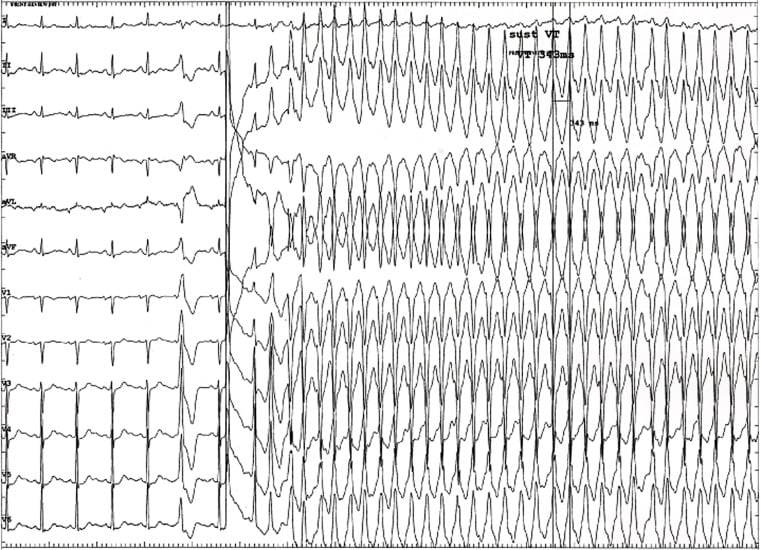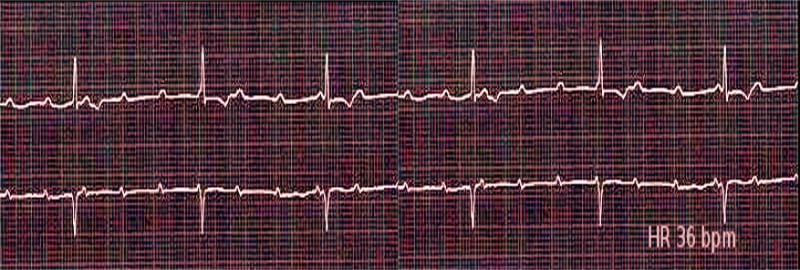I) Premature atrial complexes or PAC: They are seen in ectopic pacemakers in the atria. ECG shows an abnormal P wave followed by a normal QRS complex. A post extrasystolic pause is often seen that is a longer than normal interval before the next sinus beat. They may be unifocal or multifocal. They may occur in repeating patterns like bigeminy (every other beat is a PAC), trigeminy (every third beat is a PAC), couplets (two consecutive PACs) etc . Patients may complain of “skipped beats”. They may be benign or associated with IHD, left atrial enlargement, WPW syndrome, anxiety, beta agonists, caffeine, digoxin toxicity, IHD, sympathomimetics etc.
II) Atrial tachycardia (AT): It is a type of supraventricular tachycardia in which the atria beat at rates higher than 100/min in atrial tachycardia. The impulse originates in an ectopic site in the atria (not SA node). Patients present with palpitations, chest discomfort, dyspnea, dizziness, rarely syncope. As the rhythm is not sinus, morphology of the P wave will be slightly different from the normal sinus P wave. Atrial tachycardia is seen in children with CHD, elderly, hypertension, cardiomyopathy, alcohol or cocaine abuse etc.
Atrial tachycardia may be focal or multifocal. Focal AT originates from a single focus in the atria hence, all P waves will have similar morphology with a regular rhythm. Multifocal AT will show at least three distinct P wave morphologies as multiple arrhythmogenic foci will be generating impulses; and for the same reason, the rhythm will be irregular. Multifocal AT is commonly seen in lung disorders like PE, COPD etc.
III) Atrial flutter: It is a rapid but regular rhythm with fast atrial rates between 250-350 beats/minute. It occurs due to re-entry circuits within the atria. ECG shows regular, sawtooth like, flutter waves.
IV) Atrial fibrillation: It is characterized by disorganized electrical activity in the atria. Symptoms may be syncope, collapse, palpitations etc. It is seen in old age, HT, IHD, CCF, RHD, hyperthyroidism, alcohol abuse, electrolyte abnormalities. ECG shows an irregular rhythm with absent P waves and changing R-R interval. The ECG baseline shows fibrillatory waves with frequencies as high as 600/minute.

V) Atrioventricular or AV nodal re-entrant tachycardia (AVNRT): It is the most common type of SVT. It presents with palpitations, dizziness, dyspnea or syncope. AVNRT is caused by a re-entrant circuit near the AV node. It has a fast and slow pathway. Most commonly, the slow pathway is used for anterograde conduction from atria to the ventricle, while fast pathway is used for retrograde conduction. This is called slow-fast AVNRT. Premature atrial or ventricular contractions may precipitate AVNRT. Caffeine, tobacco, alcohol, stress or exercise may cause AVNRT. ECG shows narrow-complex tachycardia at rates typically between 120-240 beats per minute and P waves cannot be discerned.
Valsalva maneuver, intravenous adenosine and carotid sinus massage may terminate SVTs by vagal activation. Cerebral stroke from carotid thrombus embolization can occur as a result of carotid sinus massage.
VI) WPW syndrome or Wolf-Parkinson-White syndrome or pre-excitation syndrome: Underlying pathology is early depolarization of the ventricular myocardium before normal conduction through the AV node has occurred. Early and faster conduction occurs through an accessory pathway called Bundle of Kent that connects the atria to the ventricle. It is characterized on ECG by “delta wave” at the onset of the QRS complex. Any drug that blocks conduction through normal AV junction, like adenosine, calcium channel blockers and digoxin are contraindicated in WPW syndrome as they will enhance conduction through the Bundle of Kent and precipitate ventricular tachycardia.
VII) Ventricular ectopic beats or VPCs or ventricular premature complexes: They are premature beats that result from abnormal excitation of ventricles. They are typically benign. They may be associated with CAD, stimulants like caffeine, pseudoephedrine, AMI etc.

VIII) Ventricular tachycardia: It is a broad complex ventricular arrhythmia with a rate > 100/min. They can be diagnosed if more than three consecutive ventricular premature complexes occur in a row. Depending on how long VT lasts it may be non-sustained (lasts less than 15-30 seconds) or sustained (lasts longer than 30 seconds).

IX) Torsades de pointes: Also called polymorphic ventricular tachycardia. ECG shows characteristic “turning of points” along the baseline due to changing axis. It is seen in electrolyte disturbances like hypomagnesemia and hypokalemia, factors that prolong QT interval like congenital long QT syndrome, antiarrhythmics, TCAs, Romano-Ward syndrome etc. It may precipitate a ventricular fibrillation or VF.
X) Ventricular fibrillation: It is a chaotic, irregular ventricular rhythm. It is a potentially fatal rhythm. The ventricles fail as a pump as contraction is not coordinated. It is seen in AMI, CAD, cardiomyopathies, heart failure, long QT syndrome, Brugada syndrome, drugs etc. ECG shows chaotic waves without any regularity or rhythm or any identifiable P waves or QRS-T complexes. Typically it is at a very high rate ranging from 150-500/minute.
XI) Atrioventricular block or AV block: In AV block, conduction of electrical impulses from the atria to the ventricles is delayed or blocked. It may be first degree, second degree or third degree block.
In first degree AV block, the PR interval is prolonged more than 200 milliseconds (>1 big ECG square). It is seen in myocarditis, IHD, degenerative diseases of the conduction system or drugs like TCAs. No treatment is needed for the first degree block.
Second degree block can be type I or II. In type I, also called Mobitz type I or Wenckebach phenomenon, there is progressive prolongation of the PR interval till one beat is dropped. It is seen in the same conditions that cause first degree block. No treatment is necessary unless the patient is symptomatic with syncope, angina or heart failure that is exacerbated by the block. In Mobitz type II block, there is a constant PR interval but occasional beats are dropped. Typically it follows a pattern like 2:1, 3:1 block etc. For example 3:1 block means that for every 3 atrial P waves there will be only one corresponding ventricular QRS ( implying that 2 ventricular beats are dropped). Type II block is seen in disease of the conduction system distal to the AV node. Treatment is necessary and is done by temporary and permanent pacing.
Third degree heart block is also called a complete heart block. There is complete dissociation of P waves from the QRS complexes. The atria beat at their own rate while the ventricles beat at a slow intrinsic rate of 30-40 beats/min. It is seen in IHD, drug toxicity with beta blockers, digitalis and calcium channel blockers. Permanent pacemaker is essential.

XII) LBBB and RBBB: Bundle branch blocks can occur due to conduction blocks in either the right or left bundle branches. LBBB presents with an “M” pattern in V6 and “W” pattern in V1. RBBB presents with rSR’ pattern in V1 and normal looking R in V6. New onset LBBB may occur due to AMI. RBBB is common especially in PE and in smokers.
Sign up for free to take 3 quiz questions on this topic